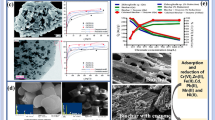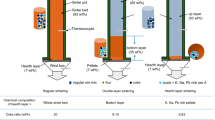Abstract
A kind of volcanic tephra (VT) as abundant natural mineral in China was studied for phosphate (P) removal from rural micro-polluted wastewater. Physical and chemical properties of VT were investigated by scanning electron microscopy (SEM), energy dispersive X-ray spectrometer (EDX), X-ray diffraction (XRD), UV-visible diffuse reflectance spectrometry, and Fourier transform infrared spectroscopy (FT-IR). The uptake of P decreased with the increase of the initial solution pH, and the optimum solution pH required for maximum P removal rate was 2.0. Zeta potential analyses were carried out to vividly describe the surface charges at different solution pH. The equilibrium data were both fitted well for Langmuir and Freundlich isotherm models. Thermodynamic parameters including changes in standard enthalpy (ΔH 0), standard entropy (ΔS 0), and standard Gibbs free energy (ΔG 0) were calculated. The removal of P was predominantly based on ion-exchange process when the initial solution pH in the range of 2.0–6.0. A given dose of VT can be recycled for eight times. VT minerals were attempted for P removal from rural micro-polluted wastewater collected in Shanghai, China containing 50 mg L−1 P, and the removal rate was determined to be nearly 100 % with the capacity of 0.5 mg P/g VT minerals. All our results indicated that VT could be a promising choice for P removal from micro-polluted wastewater in rural area with the distinct advantages of being low cost and environmentally benign.






Similar content being viewed by others
References
Bange, J., Patil, L., & Gautam, D. (2008). Growth and characterization of SiO2 films deposited by flame hydrolysis deposition system for photonic device application. Progress in Electromagnetics Research, 3, 165–175.
Bhatnagar, A., Vilar, V., Botelho, C., & Boaventura, R. (2011). A review of the use of red mud as adsorbent for the removal of toxic pollutants from water and wastewater. Environmental Technology, 32(3), 231–249.
Biswas, B., Inoue, K., Ghimire, K., Harada, H., Ohto, K., & Kawakita, H. (2008). Removal and recovery of phosphorus from water by means of adsorption onto orange waste gel loaded with zirconium. Bioresource Technology, 99(18), 8685–8690.
Buck, S., Denton, G., Dodds, W., Fisher, J., Flemer, D., Hart, et al. (2000). Nutrient criteria technical guidance manual: Rivers and streams. US Environmental Protection Agency, Office of Water.
Chen, J., Kong, H., Wu, D., Chen, X., Zhang, D., & Sun, Z. (2007). Phosphate immobilization from aqueous solution by fly ashes in relation to their composition. Journal of Hazardous Materials, 139(2), 293–300.
Chen, Z., Wang, Z., & Zhao, C. (2009). Research on pavement performance of volcanic ash road base and its mechanism. Journal of Highway and Transportation Research and Development, 25(8), 15–20. +30.
de-Bashan, L. E., & Bashan, Y. (2004). Recent advances in removing phosphorus from wastewater and its future use as fertilizer (1997–2003). Water Research, 38(19), 4222–4246.
Dogan, M., Alkan, M., & Cakir, U. (1997). Electrokinetic properties of perlite. Journal of Colloids and Interface Science, 192(1), 114–118.
Drizo, A., Cummings, J., Weber, D., Twohig, E., Druschel, G., & Bourke, B. (2008). New evidence for rejuvenation of phosphorus retention capacity in EAF steel slag. Environmental Science and Technology, 42(16), 6191–6197.
Eaton, A., & Franson, M., (2005). Standard methods for the examination of water & wastewater. American Public Health Association.
Echchahed, B., Moen, A., Nicholson, D., & Bonneviot, L. (1997). Iron-modified MCM-48 mesoporous molecular sieves. Chemistry of Materials, 9(8), 1716–1719.
Gebremariam, S. Y., Beutel, M. W., Christian, D., & Hess, T. F. (2011). Research advances and challenges in the microbiology of enhanced biological phosphorus removal—a critical review. Water Environment Research, 83(3), 195–219.
Gibson, G. (2000). Nutrient criteria technical guidance manual: Lakes and reservoirs. US Environmental Protection Agency, Office of Water.
Hanly, J., Hedley, M., & Horne, D. (2008). Evaluation of tephra for removing phosphorus from dairy farm drainage waters. Australian Journal of Soil Research, 46(7), 542–551.
Hrenovic, J., Gobac, Z. Z., & Bermanec, V. (2012). Occurrence of sepiolite in Croatia and its application in phosphate removal from wastewater. Applied Clay Science, 59, 64–68.
Huang, W., Wang, S., Zhu, Z., Li, L., Yao, X., Rudolph, V., & Haghseresht, F. (2008). Phosphate removal from wastewater using red mud. Journal of Hazardous Materials, 158(1), 35–42.
Johansson, L., & Gustafsson, J. (2000). Phosphate removal using blast furnace slags and opoka-mechanisms. Water Research, 34(1), 259–265.
Kamiyango, M., Masamba, W., Sajidu, S., & Fabiano, E. (2009). Phosphate removal from aqueous solutions using kaolinite obtained from Linthipe, Malawi. Physics and Chemistry of the Earth, Parts A/B/C, 34(13–16), 850–856.
Koilraj, P., Antonyraj, C. A., Gupta, V., Reddy, C., & Kannan, S. (2013). Novel approach for selective phosphate removal using colloidal layered double hydroxide nanosheets and use of residue as fertilizer. Applied Clay Science, 86, 111–118.
Kumar, H., Prasher, S., Patel, R., & Hussain, S. (2010). Evaluation of electric arc furnace slag as a potential phosphate-removal substrate. Journal of Environmental Engineering, 136(3), 343–346.
Liesch, A. M. (2010). Wastewater phosphorus removal by two different types of andesitic volcanic tephra. Journal of Natural Resources and Life Sciences Education, 38(1), 40–44.
Lu, S., Bai, S., Zhu, L., & Shan, H. (2009). Removal mechanism of phosphate from aqueous solution by fly ash. Journal of Hazardous Materials, 161(1), 95–101.
Namasivayam, C., & Prathap, K. (2005). Recycling Fe (III)/Cr (III) hydroxide, an industrial solid waste for the removal of phosphate from water. Journal of Hazardous Materials, 123(1–3), 127–134.
Niwas, R., Gupta, U., Khan, A., & Varshney, K. (2000). The adsorption of phosphamidon on the surface of styrene supported zirconium (IV) tungstophosphate: a thermodynamic study. Colloids and Surfaces A: Physicochemical and Engineering Aspects, 164(2–3), 115–119.
Oguz, E. (2004). Removal of phosphate from aqueous solution with blast furnace slag. Journal of Hazardous Materials, 114(1–3), 131–137.
Perrin, D., & Dempsey, B. (1974). Buffers for pH and metal ion control. London: Chapman and Hall.
Ruan, H., Frost, R., Kloprogge, J., & Duong, L. (2002). Infrared spectroscopy of goethite dehydroxylation: III. FT-IR microscopy of in situ study of the thermal transformation of goethite to hematite. Spectrochimica Acta Part A: Molecular and Biomolecular Spectroscopy, 58(5), 967–981.
Theng, B., Russell, M., Churchman, G., & Parfitt, R. (1982). Surface properties of allophane, halloysite, and imogolite. Clays and Clay Minerals, 30(2), 143–149.
USEPA, (2001). Nutrient criteria technical guidance manual: estuarine and coastal marine waters. US Environmental Protection Agency, Office of Water.
USEPA, (2008). Nutrient criteria technical guidance manual. US Environmental Protection Agency, Office of Water.
USEPA, (2012). State development of numeric criteria for nitrogen and phosphorus pollution-progress. US Environmental Protection Agency, Office of Water.
Wang, Z., Ni, W., Jia, Y., Zhu, L., & Huang, X. (2010). Crystallization behavior of glass ceramics prepared from the mixture of nickel slag, blast furnace slag and quartz sand. Journal of Non-Crystalline Solids, 356(31–32), 1554–1558.
Wilson, M. (1987). A handbook of determinative methods in clay mineralogy. Blackie.
Xiong, J., He, Z., Mahmood, Q., Liu, D., Yang, X., & Islam, E. (2008). Phosphate removal from solution using steel slag through magnetic separation. Journal of Hazardous Materials, 152(1), 211–215.
Yu, Y., Xiong, G., Li, C., & Xiao, F. (2000). Characterization of iron atoms in the framework of MFI-type zeolites by UV resonance Raman spectroscopy. Journal of Catalysis, 194(2), 487–490.
Zhang, G., Liu, H., Liu, R., & Qu, J. (2009). Removal of phosphate from water by a Fe-Mn binary oxide adsorbent. Journal of Colloids and Interface Science, 335(2), 168–174.
Zhao, L., Satoh, M., & Inoue, K. (1997). Clay mineralogy and pedogenesis of volcanic ash soils influenced by tropospheric eolian bust in Changbaishan, Sanjiaolongwan, and Wudalianchi, Northeast China. Soil Science and Plant Nutrition, 43(1), 1997.
Zhao, Y., Zhang, L., Ni, F., Xi, B., Xia, X., Peng, X., & Luan, Z. (2011). Evaluation of a novel composite inorganic coagulant prepared by red mud for phosphate removal. Desalination, 273(2), 414–420.
Acknowledgments
Financial supports were provided by the National Natural Science Foundation of China (Grant No. 20405010), the Ministry of Science and Technology, China (Grant No. SK-CN-05-08, 06–13), and the National Ocean Public Benefit Research Foundation (Grant No. 201005026).
Author information
Authors and Affiliations
Corresponding author
Additional information
Yanwen Su and Wenzhong Zhang contributed equally to this work.
Electronic Supplementary Material
Below is the link to the electronic supplementary material.
Fig. S1
Effect of VT dosage on P removal (initial P concentration = 50 mg L−1, contact time = 6 h, agitation speed = 200 rpm, temperature = 25 °C, initial solution pH = 2, and varying VT dosages of 0, 0.60, 0.75, 1.00, 1.50, 3.00, and 6.00 g/10 mL) (DOCX 222 kb)
Figure S2
Effect of contact time on P removal under dynamic and static condition (initial P concentration = 50 mg L−1, VT dosage = 1.00 g/10 mL, agitation speed = 200 rpm and 0 rpm, respectively, temperature = 25 °C, and initial solution pH = 2) (DOCX 222 kb)
Figure S3
Plots of ln(C s /C e ) vs. C s . Initial solution pH = 2.0 (●, 303 K; ■, 313 K) and initial solution pH = 6.0 (○, 303 K; □, 313 K) (DOCX 222 kb)
Figure S4
Reusability of VT after 8 cycles of P removal (initial P concentration = 50 mg L−1, VT dosage = 1.00 g/10 mL, agitation speed = 200 rpm, contact time = 10 h, and initial solution pH = 2) (DOCX 222 kb)
Figure S5
P removal from real rural wastewater at different concentrations of NO3 − (initial P concentration = 10 mg L−1, VT dosage = 1.00 g/10 mL, contact time = 10 h, and initial solution pH = 2 and 6, respectively) (DOCX 222 kb)
Rights and permissions
About this article
Cite this article
Su, Y., Zhang, W., Xu, F. et al. Natural Volcanic Tephra for Phosphate Removal from Rural Micro-polluted Wastewater. Water Air Soil Pollut 226, 2258 (2015). https://doi.org/10.1007/s11270-014-2258-5
Received:
Accepted:
Published:
DOI: https://doi.org/10.1007/s11270-014-2258-5




